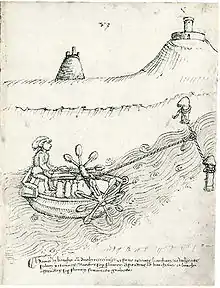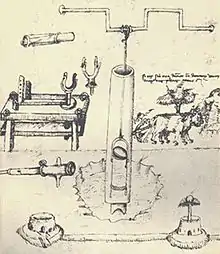Mariano di Jacopo (1382 – c. 1453), called Taccola ("the jackdaw"), was an Italian polymath, administrator, artist and engineer of the early Renaissance. Taccola is known for his technological treatises De ingeneis and De machinis, which feature annotated drawings of a wide array of innovative machines and devices. Taccola's work was widely studied and copied by later Renaissance engineers and artists, among them Francesco di Giorgio, and Leonardo da Vinci.[2]
Life and career
Mariano Taccola was born in Siena in 1382. Practically nothing is known of his early years of training or apprenticeship.[3] As an adult, he pursued a varied career in Siena, working in such diverse jobs as notary, university secretary, sculptor, superintendent of roads and hydraulic engineer.[4]Notably, he created a series of woodcarvings for the Duomo, a cathedral in Florence in June 26, 1408.[5] Taccola married a woman named Madonna Nanna, likely around 1420, and had a daughter named Alba in either 1426 or 1428.[6][7] In the 1440s, Taccola retired from his official positions, receiving a pension from the state. He is known to have joined the fraternal order of San Jacomo by 1453 and presumably died around that date.[8]
Work and style
Taccola left behind two treatises, the first being De ingeneis (Concerning engines), work on its four books starting as early as 1419.[9] In 1432, Taccola met with Sigismund of Hungary in Siena, and then traveled with him to Rome for Sigismund's coronation to become Holy Roman Emperor.[10] While at Sigismund's coronation, Taccola dedicated Books 3 and 4 of De ingeneis to Sigismund, the then protector of Taccola's native Siena, possibly as a means of gaining status and notoriety as a designer.[11] Having been completed in 1433, Taccola continued to amend drawings and annotations to De ingeneis until about 1449. In the same year, Taccola published his second manuscript, De machinis (Concerning machines), in which he restated many of the devices from the long development process of his first treatise. Taccola also worked in maintenance and advancement of Sienna's waterworks system, which was one of the most advanced of the time.[3][12] Overall, Taccola's goal of his treatises was to shed light on old Greco-Roman machines, as opposed to principally writing about his own designs.[13] On a case-to-case basis, Taccola would cite the earlier designs imagined by Vegetius and Kyeser.[10]
Drawn with black ink on paper and accompanied by hand-written annotations, Taccola depicts in his work a multitude of 'ingenious devices' in hydraulic engineering, milling, construction and war machinery. Taccola's designs credited to him include an underground explosive mine, a suction cup, an underwater breathing device, and various crane designs, among many other novel devices.[14][15] In one example, Taccola detailed the design of a defense system for forts that used a water line and a suction line.[16] Both ends of the water and suction line would be open, allowing water from a lower reservoir to flow up the water line and fill an upper reservoir in the fort.[16] Then, if under attack, the fort can release the water through a discharge hole in the side of the fort's wall, presumably so that the force of the water could push attacking forces away from the wall.[16] However, historians have questioned the seriousness of some of his designs, such as one of his designs requiring a floating cart being pulled by oxen that walked underwater without breathing.[17] There is only one reference recorded in his writings of Taccola actually creating and testing his designs, so his creations were likely mostly theoretical.[17] Taccola's drawings show him to be a man of transition: While his subject matter is already that of later Renaissance artist-engineers, his method of representation still owes much to medieval manuscript illustration.[18] Due to the political rivalry between Siena and Florence, Taccola was never exposed to linear perspective, a growing graphical style in Florence.[19] Moreover, Taccola drew his machines based on what looked proper to him, not based on geometrical considerations.[20] Despite these graphic inconsistencies, Taccola's style has been described as being forceful, authentic and usually to be relied upon to capture the essential.[21]
Interview With Brunelleschi
The contents of the interview covered the issue of protecting intellectual property from thieves, during a time when few governments in Europe had any laws on patenting.[22] Initially, Taccola was open to the idea of sharing his ideas with others, but his interview with Brunelleschi influenced him to become more cryptic, drawing more symbolic imagery in De ingeneis and explaining to the reader, "My speech has been veiled... I say what I say because of the ingratitude of some people, and not of all men.".[23] Taccola and Brunelleschi also discussed the installation of bridge and pier foundations of which Taccola had previously made two inventions for.[24] However, Brunelleschi was more modest about Taccola's inventions, telling him that he also needed to consider the availability of resources close to the body of water, highlighting Brunelleschi's experiences applying inventions in the real world, similar to modern engineers, whereas Taccola had mostly dealt with imagining new inventions, more akin to a designer.[25]
Influence and rediscovery
The work of Taccola, named the 'Sienese Archimedes', stands at the beginning of the tradition of Italian Renaissance artist-engineers, with a growing interest in technological matters of all kinds. Taccola communicated with many notable people in his time, including Brunelleschi, a notable artist, and King Sigismund, who gave him the rank of Humilate, or familiar.[26] He was also twice nominated to join the Sienese "Guild of Judges and notaries," although he failed to join both times after failing to show up for his final approval.[7] Taccola's drawings were copied and served as a source of inspiration by such as Buonacorso Ghiberti, Francesco di Giorgio, and perhaps even Leonardo da Vinci.[8] Of special historical importance are his drawings of the ingenious lifting devices and reversible-gear systems which Brunelleschi devised for the construction of the dome of the Florence cathedral,[27] at the time the second widest in the world. His works were copied as manuscripts multiple times through the 15th century.[28]
Interest in Taccola's work, however, practically ceased some time after his death until the late 20th century,[3] one reason perhaps being that his treatises circulated only as hand-copied books, with at least three of them remaining extant today.[29] Taccola's original manuscripts, whose style turned out to be more sophisticated than those of its copies, were rediscovered and identified in the state libraries of Munich and Florence in the 1960s, giving impetus for the first printed editions of both De ingeneis and De machinis in subsequent years,[29] beginning with the publishing of part of De ingeneis in 1969 by J.H. Beck.[30]
Gallery
 Overbalanced wheel and war machines, by Taccola
Overbalanced wheel and war machines, by Taccola Machines, by Taccola, De ingeneis
Machines, by Taccola, De ingeneis Paddle boat system, by Taccola, De machinis (1449)
Paddle boat system, by Taccola, De machinis (1449) Taccola "Vitruvian man"
Taccola "Vitruvian man"
References
- ↑ Hill, Donald Routledge (1996). A history of engineering in classical and medieval times. Routledge. p. 143. ISBN 0-415-15291-7.
- ↑ van den Broek, Marc (2019). Leonardo da Vinci Spirits of Invention. A Search for Traces. Hamburg: A.TE.M. ISBN 978-3-00-063700-1.
- 1 2 3 Fane, p.136
- ↑ Shelby, p.466
- ↑ Beck, p.10
- ↑ Beck p.10
- 1 2 Prager et al p.5-9
- 1 2 Fane, p.137
- ↑ Shelby, p.467
- 1 2 Knobloch, p.13
- ↑ Galluzzi, p.18
- ↑ Prager, Frank D.; Scaglia, Gustina, eds. (1971). Mariano Taccola and His Book "De ingeneis". Cambridge, Mass.: M.I.T. Press. p. 3.
- ↑ Galluzzi, p.22
- ↑ Beck, James H. (1968). "The Historical "Taccola" and Emperor Sigismund in Siena". The Art Bulletin. 50 (4): 309–320. doi:10.2307/3048568. ISSN 0004-3079.
- ↑ Shelby, p.468
- 1 2 3 Knobloch, p.16
- 1 2 Shelby, p. 469-70
- ↑ Fane, p.138
- ↑ Galluzi, p.46
- ↑ Galluzi, p.47
- ↑ Fane, p. 137ff.
- ↑ Galluzzi, p.28
- ↑ Galluzzi, p. 29-32
- ↑ Galluzzi, p.32
- ↑ Galluzzi, p.33
- ↑ Prager et al p.11-15
- ↑ Fane, p.140
- ↑ Shelby, p.471
- 1 2 Fane, p.143
- ↑ Shelby, p.472
Sources
- Beck, J.H., ed. (1969). Mariano di Jacopo detto il Taccola, 'Liber tertius de ingeneis ac edifitiis non usitatis'. Milan: dizioni il Polifilo. p. 156.
96 pls
(This edition reproduces Books III and IV of de Ingeneis) - Prager, Frank D.; Scaglia, Gustina, eds. (1971). Mariano Taccola and His Book "De ingeneis". Cambridge, Mass.: M.I.T. Press. pp. 230 pp.
129 pls.
(This edition also reproduces Books III and IV of de Ingeneis) - Scaglia, Gustina, ed. (1971). Mariano Taccola, De machinis: The Engineering Treatise of 1449, 2 vols. Wiesbaden: Dr. Ludwig Reichert Verlag. pp. 181 and 210.
200 pls.
- Fane, Lawrence (2003). The Invented World of Mariano Taccola", Leonardo. Vol. 36. pp. 135–143.
Taccola's drawings from the perspective of an artist
- Shelby, Lon (1975). "Mariano Taccola and His Books on Engines and Machines". Technology and Culture. 16 (3): 466–475. doi:10.2307/3103042. JSTOR 3103042.
Review of Taccola's treatises and its three modern editions (see above facsimile editions)
- Knobloch, Eberhard (1981). Mariano di Jacopo detto Taccolas De machinis: Ein Werk der italienischen Frührenaissance. Technikgeschichte. Vol. 48. pp. 1–27
- Galluzzi, Paolo (2020). The Italian Renaissance of Machines. Harvard University Press. pp. 1-101
External links
 Media related to Taccola at Wikimedia Commons
Media related to Taccola at Wikimedia Commons- Institute and Museum of the History of Science – Online-Exposition about Taccola's drawings
